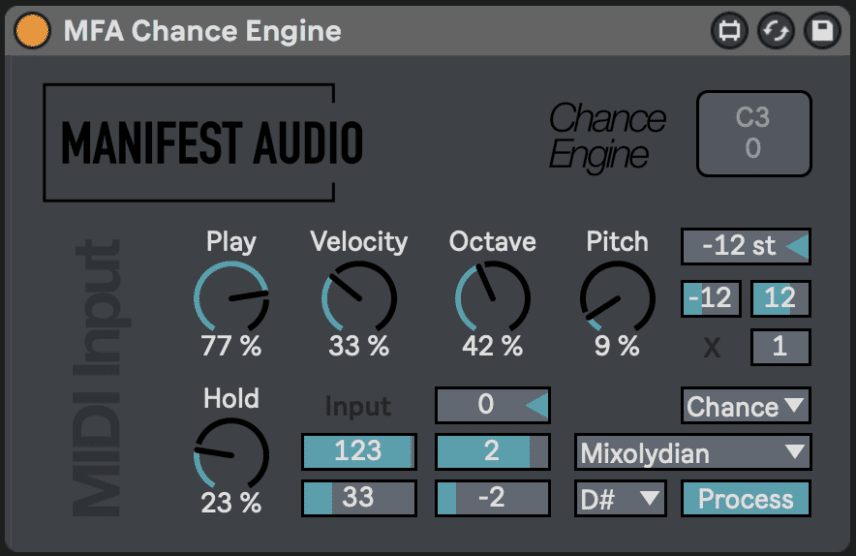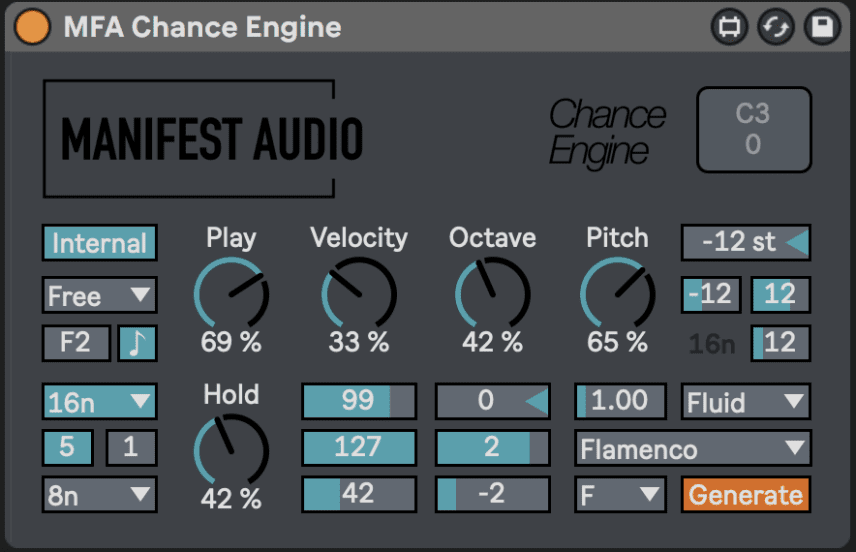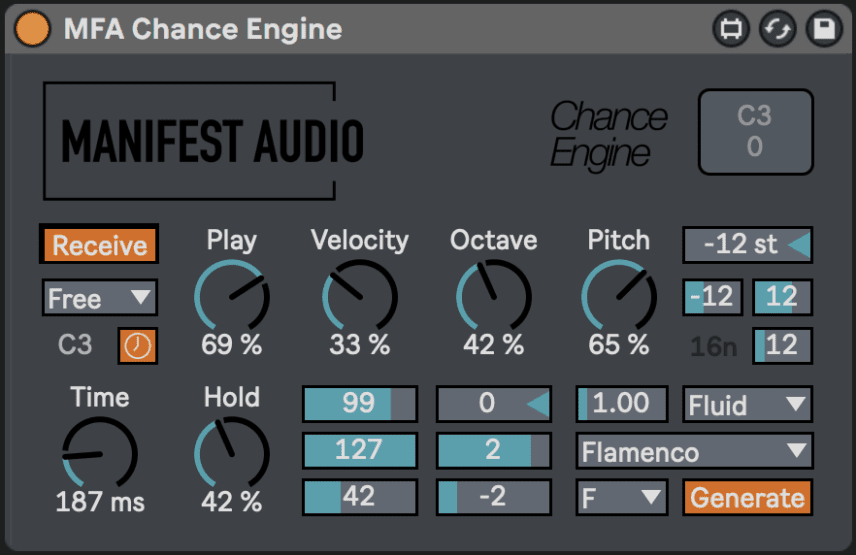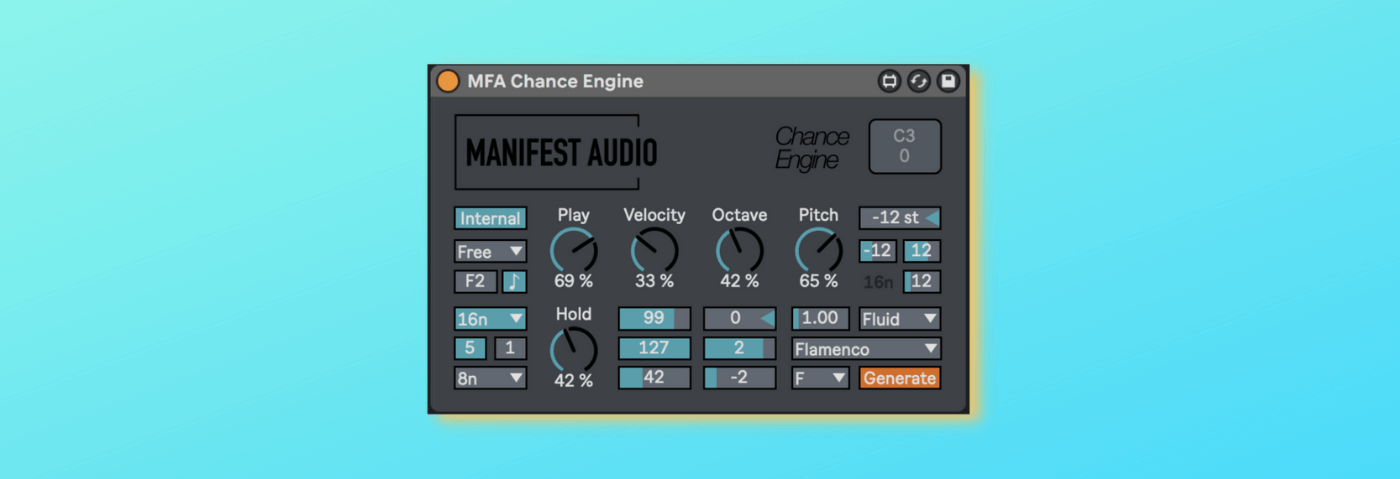A deceptively simple yet powerfully flexible Max for Live MIDI effects for Live 10 or higher, Chance Engine deploys chaos like a Swiss Army knife to cut through all manner of creative blocks.
Five main parameters randomize incoming MIDI signal in Chance Engine’s default Process mode. Play adjusts the chance notes will play, with full gating at minimum and maximum. While Live 11 provides control over the likelihood notes will play on a per-note basis, it’s not available for automation or MIDI control, as Chance Engine allows. Map Play chance to a controller and expressively build to a crescendo via increased note density with the twist of a dial – and of course, Chance Engine also works with Live 10.
Hold randomizes MIDI sustain, perfect for random note ties – especially with a bit of Octave randomization as well, the combination of which easily produces sporadic portamento glides on monophonic instruments. Velocity randomization is a must, as well as note Pitch – which comes with some handy advanced features. Octave, Velocity, and Pitch all randomize within user-defined ranges. Separate octave and transposition sliders add additional performative control, while all output conforms to one of 69 selectable scales in any key – and remains scale aware in Live 12.

Note Pitch is normally randomized with equal weighting within configured ranges in default Chance mode. Drunk mode employs a “random walk” algorithm to stumble between adjacent note pitches, while Fluid mode uses advanced maths based on the quantum motion of particles in liquid, resulting in something between Chance and Drunk that yields uniquely lyrical results. Better yet, randomization interval normally allows pitches to be randomized with every new note trigger, but can be set to a specified rhythmic interval – say, every two bars, or every six 16th notes.
Main Process mode features:
- Randomize the chance notes will play or be sustained
- Randomize the chance velocity, octave, or pitch will change within constrained ranges
- Pitch can be randomized every note, or set to randomize at nearly any rhythmic interval for controlled musical changes
- Three pitch randomization modes: Chance, Drunk, and Fluid
- Transpose in octave and semitone intervals via two separate controls
- All MIDI output conforms to one of fifty included scales in any key
- All parameters available for automation, modulation, and MIDI mapping
- Fully optimized for use with Push
- Default Process mode transforms incoming MIDI input according to the controls above; switch to Generate mode to open up new parameters and produce MIDI output on its own
- Comes with 16 presets, an 11-page manual, and full Info View annotations
So that’s Process mode – great for adding subtle variation or extreme divergence to incoming melodic or percussive material. Switching into Generate mode, Chance Engine really takes on a life of its own: as the mode suggests, Chance Engine now generates its own pulses.

With the default Internal setting, pulses play at a user-defined center pitch available for automation, modulation, and MIDI control. Switch to Receive, and the base pitch value is now determined by incoming MIDI notes, allowing you to program melodic progressions of the base pitch while randomizations percolate around it; alternatively, use this mode to anchor transposition in real-time via MIDI keyboard input.
A base metrical rate defines the rhythmic output – say, 32n, 8nd, or 4nt – which is then multiplied by a simple integer slider, so a base rate of 32n with a multiplier of 3 results in 16nd, a multiplier of 6 would be 8nd, or a multiplier of 2 would just be 16th notes. And if that’s not flexible enough, an optional offset is based on the same configuration of rate and multiplier allowing you to easily stagger rhythms off-beat.
All this combines to make just about any rhythm possible – or you can switch to a millisecond mode and go completely off grid, resulting in wild textural pitch clouds at smaller intervals with a bit of pitch randomization. Toggling in and out of milliseconds mode is seamless, as the milliseconds value inherits the equivalent of the current rhythmic setting and switching back automatically adopts the nearest base rate value.

Leave the default Free run setting and try innovative Gate and Side modes, which only allow Chance Engine to generate MIDI with incoming note on or note off signals, respectively. This lets you can easily create organic call-and response between different MIDI tracks with just a bit of In/Out matrix configuration.
Additional Generate mode features:
- Two MIDI modes, with default Internal setting the base pitch of generated notes via note slider; Receive mode takes base pitch from incoming MIDI, allowing you to program melodic progressions within which randomization will occur
- Three unique playback modes for interactive composition: Free generates pulses regardless of input Gate only generates pulses if incoming MIDI notes are held; while Side is the inverse, only generating pulses between incoming MIDI notes
- Time modes let you toggle between metrical intervals or milliseconds, with either mode inheriting the nearest interval from the other for seamless transitions
- Intricate rhythmic control over pulses, with a base rate specified anywhere between 128th notes and whole notes, including dotted and triplet options – while the rate multiplier allows for unique polymetric cycles; for example, a base rate of 16n with a multiplier of 7 will produce a pulse every seven 16th notes
- Optional offset and multiplier stagger the start of any pulse rhythm with an optional configured same as the main pulses via base metrical offset and multiplier
Random indeed – but you can easily record the output to MIDI or audio on a different track in Live to capture and collapse the infinite capabilities of Chance Engine to something a bit more predictable to edit and reliably repeat.
Chance Engine works great with any virtual instrument or external MIDI hardware. Even just a touch of velocity, hold, and octave randomization on a somewhat repetitive riff adds compelling dynamics that would be difficult to program by hand. Optimized for Push, the performative aspect makes it especially fun to play with in real-time.
Chance Engine is available on the Attack Magazine store. If you’re interested in similar MIDI tools, check out their recently-released Subtraction Engine and Toolkits chock-full of creative racks for Live.
